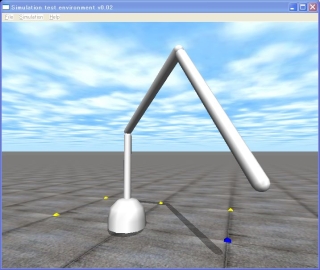
A robot arm simulator
This is the 13th ODE (Open Dynamics Engine) tutorial.
This time, let’s make a simple 3-articulated (DOF: Degree of Freedom) robot arm gathering knowledge so far. Using the ODE, you can make such a simulator only about 100 lines. Collision detentions are omitted to simplify the sample program. The robot can be operated by a keyboard. The first joint can be moved by the ‘ j’ (increase) or ‘f’ (decrease) key, ‘d’ and ‘k’ keys move the second joint, and ‘l’ and ‘s’ keys moves the third joints.
To move the joints, using a simple control, the P control, which controls the joint proportional to the difference between the current value of the angular velocity and the target velocity. The current value of joint angle values and the target are far apart, if you have a large angular velocity and angular velocity if the goal is the same as the value 0 to stop the next joint. Also, as the target for the current best value, you will be a negative sign for a reversal of rotation, and the current value is close to the target value.
The control function realizes that. dParamVel is the target angular velocity, and dParamFMax is the maximum torque to realize the angular velocity. If dParamFMax is set to 0, you cannot control the joint, because the torque is not provided to the joint.
The source code, sample13-110105.zip, can be download from here.
// sample13.cpp 3 DOF manipulator by Kosei Demura 2006-2009
#include "ode/ode.h" // ODE
#include "drawstuff/drawsutt.h"
#define NUM 4 // Number of links
dWorldID world; // A dynamic world
dBodyID link[NUM]; // Links link[0] is a base
dJointID joint[NUM]; // Joints joint[0] is a fixed joint between a base and a ground
static double THETA[NUM] = { 0.0, 0.0, 0.0, 0.0}; // Target joint angels[rad]
static double l[NUM] = { 0.10, 0.90, 1.00, 1.00}; // Length of links[m]
static double r[NUM] = { 0.20, 0.04, 0.04, 0.04}; // Radius of links[m]
void control() { /*** P control ****/
static int step = 0; // Steps of simulation
double k1 = 10.0, fMax = 100.0; // k1: proportional gain, fMax:Max torque[Nm]
printf("\r%6d:",step++);
for (int j = 1; j < NUM; j++) {
double tmpAngle = dJointGetHingeAngle(joint[j]); // Present angle[rad]
double z = THETA[j] - tmpAngle; // z: residual=target angle - present angle
dJointSetHingeParam(joint[j], dParamVel, k1*z); // Set angular velocity[m/s]
dJointSetHingeParam(joint[j], dParamFMax, fMax); // Set max torque[N/m]
}
}
void start() { /*** Initialize drawing API ***/
float xyz[3] = { 3.04, 1.28, 0.76}; // View point x, y, z [m]
float hpr[3] = { -160.0, 4.50, 0.00}; // View direction(heading, pitch, roll) [°]
dsSetViewpoint(xyz,hpr); // Set view-point and gaze direction
}
void command(int cmd) { /*** Keyboard function ***/
switch (cmd) {
case ‘j'’: THETA[1] += 0.05; break; // When j key is pressed, THETA[1] is increases at 0.05[rad]
case 'f': THETA[1] -= 0.05; break;
case 'j': THETA[2] += 0.05; break;
case 'd': THETA[2] -= 0.05; break;
case 'l': THETA[3] += 0.05; break;
case 's': THETA[3] -= 0.05; break;
}
if (THETA[1] < - M_PI) THETA[1] = - M_PI;
if (THETA[1] > M_PI) THETA[1] = M_PI;
if (THETA[2] < -2*M_PI/3) THETA[2] = - 2*M_PI/3;
if (THETA[2] > 2*M_PI/3) THETA[2] = 2*M_PI/3;
if (THETA[3] < -2*M_PI/3) THETA[3] = - 2*M_PI/3;
if (THETA[3] > 2*M_PI/3) THETA[3] = 2*M_PI/3;
}
// Simulation loop
void simLoop(int pause) {
control();
dWorldStep(world, 0.02);
// Draw a robot
dsSetColor(1.0,1.0,1.0); // Set color (r, g, b), In this case white is set
for (int i = 0; i < NUM; i++ ) // Draw capsules for links
dsDrawCapsuleD(dBodyGetPosition(link[i]), dBodyGetRotation(link[i]), l[i], r[i]);
}
int main(int argc, char *argv[]) {
dsFunctions fn;
double x[NUM] = {0.00}, y[NUM] = {0.00}; // Center of gravity
double z[NUM] = { 0.05, 0.50, 1.50, 2.55};
double m[NUM] = {10.00, 2.00, 2.00, 2.00}; // mass
double anchor_x[NUM] = {0.00}, anchor_y[NUM] = {0.00};// anchors of joints
double anchor_z[NUM] = { 0.00, 0.10, 1.00, 2.00};
double axis_x[NUM] = { 0.00, 0.00, 0.00, 0.00}; // axises of joints
double axis_y[NUM] = { 0.00, 0.00, 1.00, 1.00};
double axis_z[NUM] = { 1.00, 1.00, 0.00, 0.00};
fn.version = DS_VERSION; fn.start = &start; fn.step = &simLoop;
fn.command = &command;
fn.path_to_textures = "../../drawstuff/textures";
dInitODE(); // Initialize ODE
world = dWorldCreate(); // Create a world
dWorldSetGravity(world, 0, 0, -9.8);
for (int i = 0; i < NUM; i++) {
dMass mass;
link[i] = dBodyCreate(world);
dBodySetPosition(link[i], x[i], y[i], z[i]); // Set a position
dMassSetZero(&mass); // Set mass parameter to zero
dMassSetCapsuleTotal(&mass,m[i],3,r[i],l[i]); // Calculate mass parameter
dBodySetMass(link[i], &mass); // Set mass
}
joint[0] = dJointCreateFixed(world, 0); // A fixed joint
dJointAttach(joint[0], link[0], 0); // Attach the joint between the ground and the base
dJointSetFixed(joint[0]); // Set the fixed joint
for (int j = 1; j < NUM; j++) {
joint[j] = dJointCreateHinge(world, 0); // Create a hinge joint
dJointAttach(joint[j], link[j-1], link[j]); // Attach the joint
dJointSetHingeAnchor(joint[j], anchor_x[j], anchor_y[j],anchor_z[j]);
dJointSetHingeAxis(joint[j], axis_x[j], axis_y[j], axis_z[j]);
}
dsSimulationLoop(argc, argv, 640, 570, &fn); // Simulation loop
dCloseODE();
return 0;
}
That’s all. See you !
demu